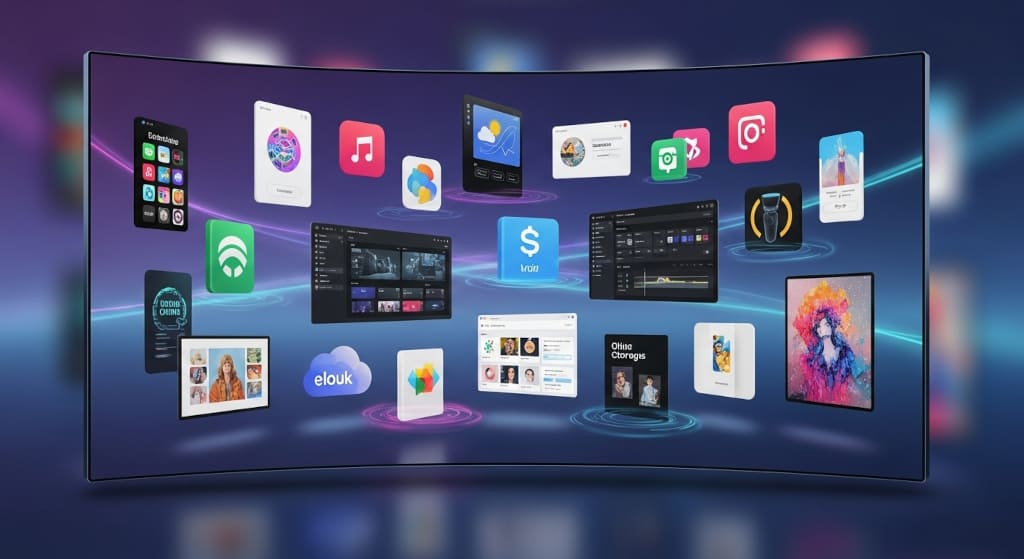In this article:
- The Digital Landlord
- The Space Baron
- The Affiliate Ambassador
- The Silent Partner
- The Digital Art Curator
Let’s be real. The idea of a “side hustle” can feel exhausting. After putting in a full day at work, the last thing you want is another job—one that demands your evenings, your weekends, and your mental energy. You see the success stories online, but they often involve grinding 80-hour weeks, mastering complex new skills overnight, or showing your face on TikTok 10 times a day. It’s enough to make anyone think, “Forget it, it’s not worth the hassle.”
What if we told you there’s a better way? What if you could build streams of income that, after an initial setup period, mostly run themselves? Welcome to the world of “set it and forget it” side hustles.
This isn’t about getting rich overnight. It’s about smart, strategic earning. It’s about leveraging assets, technology, and systems to make your money work for you, even while you sleep, relax, or focus on your main career. The goal is to build a financial cushion, save for a dream vacation, or pay off debt without sacrificing all your free time.
In this guide, we’re moving beyond the gig-economy grind and diving into the top passive and semi-passive income strategies that are perfectly suited for 2025. We’ve filtered out the hype and the overly complex schemes to bring you legitimate hustles where the upfront effort pays off in long-term, automated returns. We’ll break down exactly what each hustle entails, the realistic time and money required to start, and the potential income you can expect.
Forget trading all your time for dollars. It’s time to start building systems that generate dollars independently of your time. Let’s explore the top ways to put your finances on autopilot this year.
Side Hustle #1 – The Digital Landlord: Creating & Selling Digital Products

Imagine creating something valuable once and selling it an unlimited number of times, to customers all over the world, without ever having to manage inventory, ship a physical product, or even be awake to process an order. This isn’t a futuristic dream; it’s the reality of being a Digital Landlord. By building digital products, you create a virtual asset that generates revenue 24/7, making it the ultimate “set it and forget it” hustle for the creative mind.
What It Is:
A digital product is any intangible asset you create and sell online. Unlike a physical product, there’s no manufacturing cost per unit—your main investment is the initial time and effort spent creating it. Once it’s live on a platform, it can be purchased, downloaded, and used by customers automatically. The most common and accessible types include:
- Printable Planners & Artwork: Budget planners, workout schedules, wall art. Customers pay for the digital file and print it themselves.
- Digital Templates: Resume templates for Canva, spreadsheet budgets for Excel/Google Sheets, presentation decks.
- E-books & Guides: In-depth guides on a topic you’re knowledgeable about (e.g., “The Ultimate Guide to Urban Gardening,” “A Beginner’s Handbook to SEO”).
- Stock Photography/Videography: If you have a good eye, you can take photos or videos and license them on platforms like Shutterstock.
- Presets & Filters: Lightroom photo editing presets or social media video filters.
Why It’s a ‘Set & Forget It’ Powerhouse:
The beauty of this model is its scalability and automation. You are not trading hours for dollars. You are building a single asset that can be sold infinitely. After the initial creation and upload, the entire sales process—from payment processing to file delivery—can be handled automatically by platforms like Etsy, Gumroad, or your own website. A customer in Tokyo can buy your product at 3 AM your time, and the system delivers it instantly. It’s a true business-on-autopilot.
The Nitty-Gritty: How to Get Started in 2025
- Identify Your Niche & Audience (The Blueprint): The key to success is specificity. Instead of creating “a planner,” create “a productivity planner for freelance writers.” Instead of “stock photos,” focus on “high-quality images of cozy home offices.” Ask yourself: What specific problem can I solve? What knowledge or skill do I have that others might pay a few dollars to access?
- Create Your Product (The Construction): Use free or affordable tools. Canva is phenomenal for designing printables and templates. Google Docs or Sheets work perfectly for e-books and budget spreadsheets. Focus on high quality and a clean, professional look. This is your digital real estate—make it valuable.
- Set Up Your Storefront (The Grand Opening): You have two main paths:
- Online Marketplaces (Easiest Start): Platforms like Etsy have a massive built-in audience searching for digital products. The competition is high, but so is the traffic. It’s the fastest way to get your first sale.
- Your Own Platform (More Control): Use a service like Gumroad or Payhip. These platforms are built specifically for digital sales. They handle payments and file delivery, and you can easily embed a “Buy Now” button on your own blog or social media. This way, you keep more of the profit.
- Optimize for Discovery (The Signage): This is crucial. Your product title, description, and tags need to include the keywords your potential customers are searching for. Think like a buyer. Would you search for “budget tool” or “monthly financial planner printable PDF”? Use specific, long-tail keywords.
Potential Passive Income Stream:
Earnings can start small but grow into a significant revenue stream. A single digital product might sell for $5 to $20. Selling just 10 units of a $7 product per week generates over $3,600 in a year. The power comes from building a portfolio of products. If you have five products each generating $50 a month, that’s $250/month with very little ongoing maintenance.
Pros & Cons at a Glance:
- 👍 Pros: Extremely high profit margins (after platform fees, it’s mostly profit); truly passive after creation; scalable; reach a global audience; no physical inventory.
- 👎 Cons: Requires upfront creative time and effort; can be competitive; requires some basic marketing (keyword optimization, sharing on social media) to get initial visibility.
This hustle is perfect for organized, creative individuals who can package their knowledge or skills into a downloadable format. It’s the foundational model for modern passive income.
Side Hustle #2 – The Space Baron: Monetizing Your Unused Storage

Look around your home. Is there a garage filled with boxes you haven’t opened in years? A spare bedroom that’s become a glorified closet? An empty driveway or parking spot? If so, you’re sitting on an untapped revenue stream. The “Space Baron” hustle is about renting out these underutilized spaces to people in your community who need storage. It’s a powerfully simple concept: you have space, someone else needs it, and you get paid for the privilege.
What It Is:
This hustle involves listing and renting out storage space you aren’t using. This isn’t about building a mini-warehouse; it’s about leveraging what you already have. The rise of peer-to-peer platforms has made this safer, easier, and more accessible than ever. The types of space you can rent are surprisingly varied:
- Attic, Basement, or Garage Space: Ideal for storing seasonal items (holiday decorations, winter tires), sporting equipment, or archive boxes for local families or students.
- Spare Room or Closet: Perfect for someone living in a small apartment nearby who needs a little extra space for clothing, collectibles, or important documents.
- Driveway or Parking Spot: A goldmine if you live near a city center, airport, train station, or a large event venue. People will pay for convenient, affordable parking.
- Specialized Storage: A secure garage for a vehicle (classic car, motorcycle, RV), or even a cool, dark basement for wine storage.
Why It’s a ‘Set & Forget It’ Powerhouse:
Once you’ve listed your space and found a reliable renter, the income becomes highly predictable. Many storage arrangements are monthly, meaning you get a recurring payment for providing access to a static space. The interaction is minimal—often just providing access via a key code or garage door opener. The space is just there, working for you without any active effort on your part. It’s the ultimate in low-touch, high-value asset utilization.
The Nitty-Gritty: How to Get Started in 2025
- Audit Your Available Space (The Asset Assessment): Be brutally honest. How much space do you truly have available? Is it 50 square feet in a corner of the garage? A 100-square-foot room? Measure it. Assess its condition: Is it dry, secure, and clean? Is it accessible without going through your main living area? Take clear, well-lit photos.
- Choose Your Platform (The Marketplace): The safest way to start is by using a dedicated platform that handles payments, offers insurance, and vets users. The leader in this space is Neighbor.com, which functions like an “Airbnb for storage.” Other options include Stache and Spacer. For parking spots, SpotHero and Pavemint are excellent.
- Craft a Winning Listing (The Advertisement): Your listing is your sales pitch. Be detailed and transparent.
- Title & Description: Be specific. “Dry, Secure 5’x10′ Garage Space in North Suburb” is better than “Storage for Rent.” Mention amenities like 24/7 access, lighting, and security features.
- Photos are Critical: Show the space empty, clean, and well-lit. Highlight any positive features like shelving, a concrete floor, or a locked door.
- Set Clear Rules: What can and cannot be stored? (e.g., no perishables, hazardous materials, or illegal items). What are the access hours?
- Screen Your Renters (The Vetting Process): The platform will help, but communication is key. Have a brief chat with potential renters to understand what they plan to store and for how long. Trust your instincts. A good platform will have a user review system.
Potential Passive Income Stream:
Income is determined by your location, the type of space, and its size. Renting a single parking spot in a desirable urban area can bring in $50-$300+ per month. A small garage space might fetch $75-$200/month. A full driveway for an RV could be $100-$400/month. While not life-changing money on its own, it’s a fantastic way to turn a completely non-performing asset into a consistent cash flow.
Pros & Cons at a Glance:
- 👍 Pros: Monetizes an asset you already own (your property); very low time commitment after setup; monthly recurring revenue model; platforms provide insurance protection.
- 👎 Cons: Requires you to be comfortable with someone accessing part of your property; not completely hands-off if you need to coordinate access; income potential is limited by the physical space you have available.
This hustle is ideal for homeowners or anyone with a dedicated, unused area. It requires minimal skill beyond being organized and a good communicator, turning your extra square footage into a silent income partner
Side Hustle #3 – The Affiliate Ambassador: Earning Through Strategic Recommendations

Think about the last time you asked a friend for a product recommendation. That trusted advice is incredibly powerful. Now, imagine if you could get paid for giving that same honest, helpful advice to a wider audience. That’s the core of the “Affiliate Ambassador” hustle. You’re not selling directly; you’re a curator, a trusted source. When you recommend a product or service you genuinely believe in and someone makes a purchase through your unique link, you earn a commission. It’s a win-win-win: the buyer gets a great recommendation, the company gets a sale, and you get a cut for your influence.
What It Is:
Affiliate marketing is a performance-based revenue model. You sign up for free for a company’s affiliate program (like Amazon Associates, ShareASale, or Impact Radius). They provide you with a special tracking link. You place this link in your content—whether that’s a blog post, a YouTube video description, a social media post, or even a dedicated newsletter. When someone clicks your link and buys the product, the company tracks it and pays you a percentage of the sale. You are essentially a commission-based digital salesperson.
Why It’s a ‘Set & Forget It’ Powerhouse:
The passive potential here is massive because of what’s called “evergreen content.” Once you create a high-quality piece of content—like a blog post titled “The Best Budget Laptops for Students in 2025″—it can sit on the internet and attract readers through Google search for years. Every single person who finds that article and uses your links to buy a laptop generates a commission for you, long after you’ve finished writing. A single, well-ranked article can become a mini ATM, paying out repeatedly with zero additional work. It’s a hustle built on the compound interest of content.
The Nitty-Gritty: How to Get Started in 2025
- Choose Your Niche (The Foundation): This is the most critical step. Your success depends on becoming a trusted voice in a specific area. Your niche should be a intersection of:
- Your Passion/Knowledge: (e.g., hiking, personal finance, coffee, gaming).
- Market Demand: Are people buying products in this category?
- Affiliate Program Availability: Do companies in this space have good affiliate programs?
- Good Niche Example: “Sustainable Home Goods” – you can recommend specific brands of bamboo sheets, safety razors, and cleaning products.
- Bad Niche Example: “Stuff” – too broad and untrustworthy.
- Select Your Platform (Your Megaphone): You need a place to publish your recommendations. The best long-term asset is your own blog or website. This gives you full control and allows your content to rank on Google. Other powerful platforms include a YouTube channel (for product reviews) or a dedicated Instagram/TikTok account (for visual products).
- Create Value-First Content (The Trust Building): This is not about slapping links everywhere. Your primary goal must be to help your audience. Create genuine, in-depth reviews, “best of” lists, and helpful tutorials. Your affiliate links should be a natural, helpful part of the content. For example, in a “Home Office Setup on a Budget” article, you would naturally link to the specific keyboard, monitor, and chair you recommend.
- Join Affiliate Networks & Programs (The Toolbox): Start with the big players:
- Amazon Associates: The largest, with almost every product imaginable. Commissions are relatively low but it’s a great starting point.
- ShareASale / CJ Affiliate: These are networks that house thousands of individual merchant programs (from small brands to large ones like Lowe’s or GameStop). You can apply for many programs with a single account.
- Direct Brand Programs: Often, the best commissions come from going directly to a brand you love and seeing if they have an affiliate program on their website.
Potential Passive Income Stream:
Earnings can range from a few dollars to a full-time income, but it’s a slow burn. A beginner might earn $50-$100/month in their first year from a handful of blog posts. But as you build a library of 50+ high-quality articles, that traffic—and income—compounds. Commissions can be anywhere from 1% (on high-ticket electronics) to 50% (on digital software courses). The key is volume and trust.
Pros & Cons at a Glance:
- 👍 Pros: Extremely low startup cost (just a domain and hosting); truly passive income from evergreen content; potential for very high, scalable earnings; you can build a valuable asset (your website).
- 👎 Cons: Requires significant upfront work with no immediate payoff; it can take 6-12 months to see meaningful traffic and income; requires basic SEO and content creation skills; income is not guaranteed and can fluctuate.
This hustle is perfect for people who are passionate about a topic, enjoy creating content (writing or video), and have the patience to play the long game. It’s one of the most powerful ways to build a sustainable online income.
Side Hustle #4 – The Silent Partner: Earning Dividends with Stock Market ETFs

When you hear “investing,” you might picture a high-stress scene of day traders staring at blinking screens. But what if we told you there’s a way to invest that is the polar opposite? Imagine instead becoming a “Silent Partner” in hundreds of America’s biggest companies—without ever having to analyze a single stock. Your money quietly works in the background, earning a share of the profits from corporate giants like Apple, Microsoft, and Coca-Cola. This is the power of building a portfolio focused on dividends and ETFs (Exchange-Traded Funds), the ultimate “set it and forget it” wealth-building strategy.
What It Is:
This hustle is about making your money earn its own money through two key concepts:
- Dividends: These are regular cash payments that companies share with their shareholders (the owners) from their profits. It’s like getting a tiny slice of the company’s earnings simply for holding a piece of it.
- ETFs (Exchange-Traded Funds): Instead of the risky game of picking individual stocks, you can buy a single ETF that itself holds a small piece of every company in a major index, like the S&P 500 (which includes 500 of the largest US companies). It’s like buying a pre-made, diversified basket of stocks in a single transaction. This instantly spreads your risk and requires zero stock-picking skill.
Why It’s a ‘Set & Forget It’ Powerhouse:
This is the definition of passive income. Once you set up an automatic investment plan, the entire system runs without you. You can automate transfers from your bank account to your brokerage account, and even automate the purchases of your chosen ETFs. The dividends are then paid out automatically, typically every quarter, into your account. You can choose to reinvest them to buy more shares (powering up “compound interest”) or eventually use them as cash flow. There are no customers, no products to create, and no maintenance. It’s a financial system on autopilot.
The Nitty-Gritty: How to Get Started in 2025
- Open a Brokerage Account (Your Command Center): This is easier than opening a bank account. The best platforms for beginners are Fidelity, Charles Schwab, or Vanguard. They have no account minimums and no fees for basic stock/ETF trades. The entire process is done online in under 15 minutes.
- Fund Your Account (Fueling the Engine): Connect your checking account to your new brokerage account and transfer an initial amount. You don’t need thousands of dollars to start. Many ETFs allow you to buy a single share for less than $100, and some platforms even allow you to buy fractional shares (a piece of a share) for as little as $5.
- Choose Your Foundation ETF (Picking Your Basket): Don’t overcomplicate this. For 99% of people starting out, the perfect foundation is a low-cost S&P 500 Index ETF. The most famous example is the Vanguard S&P 500 ETF (Ticker: VOO). This single investment makes you an owner in the 500 largest US companies. It’s diversified, historically stable over the long term, and pays a dividend.
- Set Up Automation (The Autopilot Switch): This is the crucial “set it and forget it” step. Inside your brokerage account, find the “Automatic Investment” or “Recurring Investments” feature. You can schedule a transfer of $50, $100, or $500 from your bank account every single month and have it automatically used to buy more shares of your chosen ETF. Once this is done, your wealth-building machine is running.
Potential Passive Income Stream:
This is a long-term game, not a get-rich-quick scheme. The S&P 500 has historically returned an average of about 10% per year, which includes both share price growth and dividends. The dividend yield itself is typically around 1.5%. That means on a $10,000 investment, you might earn about $150 per year in dividends alone, paid out in quarterly installments. The real magic happens over decades as compound growth takes effect. A few hundred dollars invested monthly can grow into a significant portfolio generating substantial quarterly income.
Pros & Cons at a Glance:
- 👍 Pros: The most passive income possible; extremely low maintenance; builds long-term wealth; accessible to everyone with any amount of money; teaches valuable financial discipline.
- 👎 Cons: Returns are not guaranteed and the market can go down in the short term; it is a very long-term strategy, not for immediate income; requires discipline to keep investing and not panic-sell during market dips.
This hustle is non-negotiable for anyone serious about financial independence. It requires minimal financial knowledge to start, just the discipline to set it up and let time do the heavy lifting. It’s the silent engine of wealth creation.
Side Hustle #5 – The Digital Art Curator: Earning Royalties from Micro-Tasks

What if you could get paid over and over again for a task that takes less than an hour? Not for a massive project, but for a single photo, a short audio clip, or a 30-second video loop? Welcome to the world of micro-task royalties. As a “Digital Art Curator,” you’re not creating full-length novels or feature films; you’re creating the essential building blocks of the digital world. Every website, mobile app, YouTube video, and presentation needs these assets. By creating and uploading them to specialized platforms, you can earn a small royalty every single time someone downloads your work, anywhere in the world.
What It Is:
This hustle involves creating and licensing small, high-quality digital assets on stock content platforms. Unlike creating a full digital product (like an eBook) that you sell yourself, here you’re supplying a marketplace that sells to other creators. The key is volume and quality. You create an asset once, upload it, and the platform handles the rest. The primary types of micro-assets include:
- Stock Media: Photos, video clips (b-roll), and audio clips/music loops.
- Digital Elements: Fonts, graphics, icons, and templates for programs like Photoshop or Figma.
- Micro-Tasks: Some platforms even pay for small digital tasks like data categorization or short transcriptions.
Why It’s a ‘Set & Forget It’ Powerhouse:
This model thrives on the “long tail” of content. A single photo might only earn you $0.30 per download. But if you have a portfolio of 500 photos, and each one gets downloaded a few times a month from customers across the globe, those micro-payments add up to a significant monthly royalty check. The platforms are open 24/7, marketing your portfolio to millions of potential users. After the initial upload, your involvement is zero. Your assets work for you indefinitely, making it an incredibly scalable and passive income stream.
The Nitty-Gritty: How to Get Started in 2025
- Identify Your Micro-Skill (The Asset Audit): You don’t need to be a professional artist. What can you create?
- Got a smartphone with a good camera? You can take stock photos. Focus on niche subjects: hands typing on a laptop, cozy coffee shop scenes, specific plants, or abstract textures.
- Good with basic graphic design? Create simple social media quote templates, icons, or patterns using free tools like Canva or Inkscape.
- Have a quiet room? Record short, high-quality ambient audio clips (e.g., “coffee shop chatter,” “rain sounds,” “keyboard typing”).
- Choose Your Platform(s) (The Gallery): Diversify across multiple marketplaces to maximize your reach. The major players are:
- For Photos/Videos: Shutterstock, Adobe Stock, Getty Images/iStock.
- For Audio/Music: Epidemic Sound, AudioJungle, Pond5.
- For Digital Elements: Creative Market, Envato Elements.
- Create & Optimize for Discovery (The Upload): This is a two-part process.
- Quality is Key: Ensure your assets are technically perfect—high resolution, clean audio, professional formatting. A small, high-quality portfolio outperforms a large, sloppy one.
- Keyword Like a Pro: This is 90% of the battle. When you upload a photo of a “businessperson holding a tablet in a modern office,” you must tag it with every relevant term: business, technology, office, success, tablet, meeting, modern, woman, suit, etc. The more accurate keywords you use, the more likely your asset is to be found in searches.
- Build a Portfolio, Not Just a Piece (The Volume Game): Consistency is crucial. Don’t just upload one photo and wait. Set a goal to upload 5-10 new assets per week. A portfolio with 100+ items will start generating noticeable, consistent royalties. Focus on a specific niche to become a go-to source in that area.
Potential Passive Income Stream:
Earnings start small but are cumulative. A beginner might earn $10-$50 in their first month from a small portfolio. As your portfolio grows into the hundreds or thousands of assets, it’s common for established contributors to earn a few hundred to a few thousand dollars per month entirely from past work. The income is a slow drip that eventually fills the bucket.
Pros & Cons at a Glance:
- 👍 Pros: Earn royalties forever from a single task; extremely low barrier to entry (just a skill and a smartphone/computer); platforms handle all marketing and sales; global reach; great for creative individuals.
- 👎 Cons: Requires upfront time to build a critical mass of assets; individual payouts are very small; can be competitive; requires patience and consistency.
This hustle is ideal for creatively inclined people who enjoy producing small, high-quality assets and have the discipline to build a portfolio over time. It turns your minor creative acts into a perpetual revenue machine.
Conclusion – Your Autopilot Income Journey Starts Now
We’ve journeyed through five powerful strategies designed to put your finances on autopilot. From the creative freedom of being a Digital Landlord to the strategic ownership of a Silent Partner in the stock market, the path to generating income independent of your time is clearer than ever.
The common thread weaving through each of these hustles is the powerful shift from trading time for money to building systems that generate money. The initial effort you invest—whether it’s designing a digital product, cleaning out a garage space, writing a detailed review, setting up an automatic investment, or uploading a portfolio of photos—is an investment in a future where your assets work for you.
Remember, the goal isn’t to implement all five at once. That would be a recipe for burnout, the very thing we’re trying to avoid. The true “Guru” move is to start with one.
Review the list and ask yourself:
- Which one aligns with my current assets? (Do I have extra space? A little startup capital? A specific skill?)
- Which one excites me the most? (Passion will fuel the initial setup phase.)
- Which one can I start within the next 7 days?
The biggest mistake is inaction. You don’t need to be an expert to begin. You become an expert by starting. Open that Etsy shop for a single digital printable. List your parking space on Neighbor for a month. Write your first “best of” blog post. Open a brokerage account and buy $50 of an S&P 500 ETF.
Small, consistent actions build powerful, passive results. The journey to financial flexibility isn’t a sprint; it’s a marathon run on autopilot. You’ve now got the map. The only thing left to do is take the first step.
Your crate of financial wisdom is full. It’s time to unpack it and build your future.